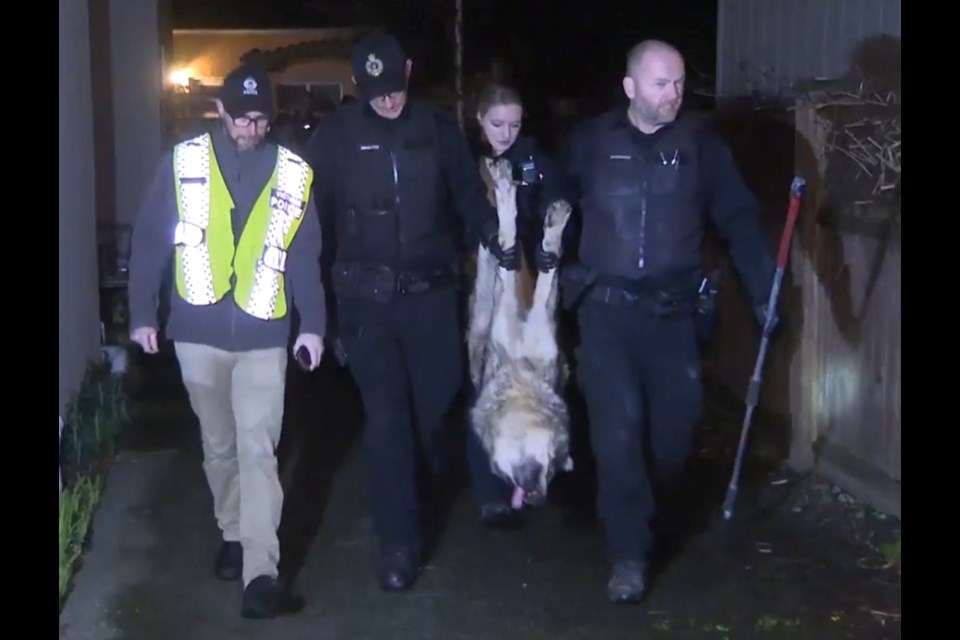A wolf that roamed a Victoria neighbourhood over the weekend has been captured and relocated to a remote area on the west side of Vancouver Island.
The male wolf weighing about 70 pounds was captured Sunday night, examined by a provincial veterinarian and assessed as a suitable candidate for release, the B.C. Conservation Officer Service said on Monday.
In the absence of DNA confirmation, dental records led conservation officers to believe the wolf is Takaya, a wolf that appeared on Discovery Island, about five kilometres east of Oak Bay, in 2012.
“It appears to be the same wolf,” said conservation officer Mark Kissinger. “But I can’t confirm it.”
Takaya has also been seen on Chatham Island and has swum across to Greater Victoria before.
By the time Kissinger caught up with the wolf in James Bay on Sunday night, the animal was exhausted.
“He had just been panicking and running straight for two days,” said Kissinger. “He did not want to be in James Bay.”
The wolf had also apparently gone to great lengths to get off Discovery Island, leading conservation officers to conclude he should not be returned there.
“It spent a lot of energy and effort getting away from Discovery Island, so it was deemed it didn’t want to be there and would be at risk by putting it back there,” said Kissinger.
“The fact this animal swam off the island several times and made such an arduous effort to get across that channel, it is obvious it’s trying to get out of there,” said Kissinger, who conceded conservation officers can’t be certain of the motivations of the wolf.
Conservation officers also reasoned, however, that if the relocated wolf is not Takaya, bringing another wolf to Discovery Island would result in a territorial fight “and one of them will end up dying.”
There is no telling if the wolf will do well in its new habitat, but the same type of hunting grounds — forest and coastal waters — will be accessible, said Kissinger.
“He’s a pretty smart wolf and he learned to adapt, looking under rocks and catching seals,” he said.
“They do get pretty prey-specific as they mature and hone their hunting skills, but he’s been relocated to an area where there is a mixture of habitats, including coastal shore, so hopefully he’ll be able to maintain his same style of life.”
There is also no guarantee the wolf won’t return.
“They are really amazing and if they really want to come back to a place, they will,” said Kissinger.
The B.C. Conservation Officer Service does not want to reveal the wolf’s new location, suspecting that many people will want to find it.
The conservation service posted a video of the wolf being released from its holding tank. Once released, it sauntered down a gravel road, looked back at least once, and continued toward a distant backdrop of low-lying clouds and tree-covered mountains.
The first official sighting of the wolf was Saturday afternoon, when conservation officers saw the animal.
The official sighting prompted warnings from police to keep children and pets indoors.
B.C. Parks suggested that anyone who sees a wolf and is more than 100 metres away should attempt to scare the animal by raising their arms and waving them in the air to appear larger. Residents were warned that if a wolf displays aggressive behaviour, they should back away slowly and refrain from turning away from the animal.
The wolf initially seemed to have disappeared, but was seen again on Sunday and was cornered and tranquilized that night by conservation officers.
At that time, the male wolf appeared to be similar in appearance and age to the Discovery Island wolf, said Kissinger.
Cheryl Alexander, a Victoria-based photographer who has been studying Takaya for six years, believes the wolf could be Takaya because the animal has similar markings. She said it could also be a female wolf that was seen at the end of 10 Mile Point in Saanich and the Blenkinsop Valley in the fall, or another wolf entirely.
Alexander goes out frequently to see Takaya. The last time she saw the wolf was a couple of weeks ago, but on a visit to the island Sunday, she saw fresh paw prints, which suggested to her that the animal had been there in the last day or two.
It’s not unusual for the wolf to travel between islands, she said, adding Takaya’s territory includes multiple islands. Alexander said coastal wolves tend to be mobile and can swim up to 10 kilometres.
“He’s an excellent swimmer. He swims in very strong currents. He also has a huge stamina,” Alexander said. “These coastal wolves are pretty adept at swimming.”
Takaya was the focus of a popular CBC documentary last year that also aired in the U.K., which created an international fanbase for the animal.
“There are so many people who care about this wolf now,” said Alexander, who has received notes from people around the world worried about Takaya.
Wolves are periodically seen in more rural areas of the South Island, such as Sooke and Metchosin, but it’s rare for them to venture into more populated parts, according to conservation officers. More than 100 but fewer than 1,000 wolves live on Vancouver Island, Kissinger estimated.
Interacting with the wolf over the weekend was a great experience, said Kissinger.
“It’s a beautiful animal and it’s one of those feel-good stories when you get to relocate an animal and put it in a good habitat and see it run off safely,” said Kissinger. “It’s fantastic.”



